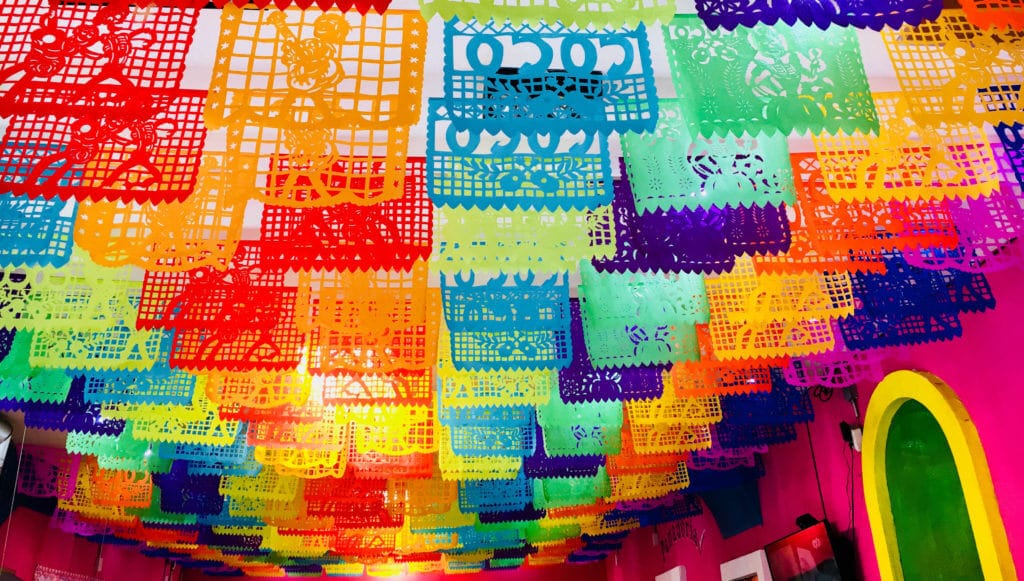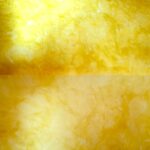Get ready to dive into the colorful world of papel picado, a Mexican folk art that’s been making waves for centuries. From its humble beginnings to the amazing creations we see today, we’re going to explore the stories and symbols behind this beautiful art. We’ll meet the artists who bring papel picado to life, learn about its role in Mexican traditions, and even see how it’s inspiring people all over the world. So, let’s jump right in and discover the magic of papel picado!
History of Papel Picado
Papel picado, those beautiful banners of intricately cut tissue paper, possesses a history as rich and colorful as the designs themselves. It’s a tale that likely begins with the invention of paper itself in ancient China. Imagine delicate paper crafts, perhaps used for ceremonies and decorations, existing as far back as those early days. As trade routes flourished, this art of paper cutting journeyed across the globe, eventually finding a new home in Mexico sometime during the 19th century, possibly with the arrival of tissue paper from Europe in the 16th century.
The town of San Salvador Huixcolotla, nestled in the heart of Puebla, Mexico, embraced papel picado with open arms, and it was here that the craft truly blossomed. Picture this: farmworkers, taking a break from the fields, would transform simple tissue paper into intricate designs, expressing their creativity and keeping traditions alive. Their techniques and patterns, passed down through generations, are still used today, preserving a direct link to the past.
Speaking of traditions, papel picado is practically synonymous with one of Mexico’s most iconic celebrations: Día de Muertos, the Day of the Dead. While some might find the holiday somber, Día de Muertos is actually a joyous occasion – a time to remember and celebrate loved ones who have passed on. And papel picado plays a huge role in setting the scene.
Imagine vibrant, elaborate designs hung in homes, businesses, and cemeteries, transforming the atmosphere with their cheerful presence. These aren’t just pretty decorations, though. Each image holds meaning, symbolizing different aspects of life, death, and the beliefs surrounding this special time of year. Skulls, for example, represent departed souls, while flowers symbolize the beauty and fragility of life.
The designs themselves are a fascinating blend of influences. Some experts believe you can see echoes of ancient Mesoamerican motifs, hinting at the use of paper in rituals long before the arrival of the Spanish. Others point to the influence of European paper cutting traditions, brought over during the colonial period. The result is a unique and ever-evolving art form, a testament to the way cultures intertwine and inspire.
Even today, papel picado continues to evolve. New generations of artists are experimenting with different techniques, colors, and subject matter, pushing the boundaries of this traditional craft. So, the next time you see papel picado, take a moment to appreciate the history woven into each delicate cut, a history that speaks of cultural exchange, artistic innovation, and the enduring power of tradition.
What is the meaning behind papel picado?
Beyond its delicate beauty, papel picado holds a depth of meaning. Each tiny cut-out seems to whisper a story about life, death, and what lies beyond. Think of it as a colorful conversation with the spirit world – something Mexicans have been doing for centuries, especially during Day of the Dead celebrations.
The true magic of papel picado lies in its symbolism. It’s like a secret language spoken through colors and shapes. For example, bright orange often speaks of mourning and loss, a gentle reminder of those who have passed. Bold red honors the memory of fallen warriors and mothers who died in childbirth, their sacrifice forever remembered. Royal purple, on the other hand, connects deeply with spirituality and the mysteries of the afterlife.
Woven into these vibrant sheets of paper are intricate designs – animals, flowers, and sacred symbols passed down through generations. Each one tells a tale of Mexico’s rich history and cultural tapestry, a testament to the resilience and beauty of its people.
While the origins of this beloved Mexican art form can be traced back to ancient China and the art of papermaking, it wasn’t until the 19th century that papel picado found its way to Mexican shores, eventually settling in the town of San Salvador Huixcolotla, Puebla. It was there that it blossomed from a simple craft into a true art form.
Although we have a good understanding of the origins and symbolism of papel picado, ongoing research continues to shed light on its evolution and regional variations. Some experts suggest that certain designs might hold different meanings in different parts of Mexico, adding another layer of complexity to this fascinating art form. As you marvel at the intricate beauty of papel picado, remember that you’re witnessing not just paper and scissors at work, but a vibrant tapestry of history, culture, and beliefs that continues to captivate hearts and minds.
What does papel picado symbolize?
Beyond its visual appeal, papel picado, especially during Day of the Dead celebrations in Mexico, holds deep cultural significance and symbolism. The delicate, almost fragile, tissue paper serves as a powerful reminder of how fleeting and precious life is – a visual metaphor for the transient nature of our existence.
The intricate cutouts, those little windows in the paper, are more than just decorative. They act as symbolic gateways. Some believe these openings allow the spirits of loved ones to pass through during Day of the Dead, blurring the lines between the physical world and the afterlife.
And then there are the vibrant colors, each hue adding another layer of meaning. Yellow, for instance, often represents mourning, a solemn reminder of those who have passed. Purple, on the other hand, is associated with purity and spirituality – fitting for a celebration that honors the souls of loved ones.
Papel picado also embodies the element of wind. Imagine those colorful banners swaying in the breeze – it’s a visual representation of the invisible forces that connect us, both the living and the departed. It’s a reminder that even though our loved ones are physically gone, their spirits and memories are still very much alive, carried on the wind and in our hearts.
Here’s a little table to summarize some of the key symbolism:
| Symbol | Meaning |
|---|---|
| Tissue Paper | The fleeting nature of life |
| Cutout Designs | Passages for spirits, connection to afterlife |
| Yellow | Mourning, remembrance |
| Purple | Purity, spirituality |
| Wind | Connection between the living and the dead |
It’s fascinating to consider how such a seemingly simple art form can hold so much depth and meaning. Papel picado is a testament to the enduring power of tradition, a vibrant expression of cultural beliefs, and a poignant reminder of life, death, and the invisible threads that bind us all.
Who created the papel picado?
While we can’t pinpoint the exact “inventor” of papel picado, we can trace its journey across time and continents. Tissue paper, originating in China in the 16th century, eventually made its way to Mexico thanks to European trade routes in the 19th century.
In the town of San Salvador Huixcolotla in Puebla, Mexico, skilled artisans saw the potential of this delicate paper and began crafting intricate designs. Like wildfire, the art of papel picado spread throughout Mexico.
And it wasn’t just for decoration. Papel picado became intertwined with celebrations – Day of the Dead altars were adorned with them, weddings and baptisms came alive with their colors, and even Christmas festivities embraced their charm. Some experts suggest this fusion of tradition and artistry cemented its place in Mexican heritage.
Papel picado’s fame traveled beyond borders, captivating hearts across the globe. Today, it’s not uncommon to find homes, offices, and even public spaces decorated with these vibrant paper creations, carrying a piece of Mexican culture wherever they go.
The history of art and tradition is full of twists and turns, and new discoveries are always possible. Who knows what other secrets about papel picado are waiting to be unveiled?
When did papel picado start?
The story of papel picado goes way back, intertwining with ancient traditions and the creativity of Mexican artisans. The Aztecs, deeply connected to spirituality, carved intricate figures into a special type of bark paper called amate. These weren’t just decorations; they represented spirits and played a role in their rituals.
Fast forward to the mid-1800s. Mexican artisans, inspired by these ancient practices, decided to try something new. They took delicate tissue paper, readily available from local haciendas, and transformed it into the elaborate cutout designs we know as papel picado.
The town of San Salvador Huixcolotla in Puebla became the place for this art form to flourish, known for its incredibly skilled artisans and their unique, intricate designs.
Over time, the tools evolved too. Initially, artisans used scissors, but they eventually discovered that chisels offered greater precision, allowing for even more intricate details. The designs themselves weren’t stuck in the past either! While traditional motifs remained, papel picado began to incorporate a wider range of themes, colors, and patterns, reflecting the ever-evolving cultural tapestry of Mexico.
This evolution is still ongoing! There’s so much we can still learn about papel picado’s journey. Imagine uncovering more about its significance within Aztec culture, understanding how the techniques used in San Salvador Huixcolotla have been passed down through generations, and exploring how modern materials and technology might shape its future. Each of these paths offers a fascinating glimpse into the living history of this beautiful art form.
What are the symbols of papel picado?
Papel picado, those beautiful cut-paper banners that just scream “celebration!” in Mexican culture, are more than just pretty decorations. Each design, carefully snipped into existence, whispers a story, rich in symbolism and steeped in tradition.
Skulls and skeletons, often seen in papel picado, aren’t meant to be morbid. Instead, these playful calaveras remind us of life’s fleeting nature and the cyclical dance between life and death – a key theme in Mexican culture. Remember, it’s all about celebrating life, even in the face of death!
Flowers are like the rock stars of the natural world when it comes to symbolizing life, growth, and beauty. But just like real flowers, their beauty is a fleeting pleasure, a gentle reminder of life’s precious and temporary nature.
Animals often strut their stuff in papel picado as well, from proud eagles soaring high to mystical jaguars prowling under a paper moon. Each critter usually represents a specific deity or ancestral spirit, maybe even a legendary creature from Mexican folklore. They bring a little extra “oomph” to the party – strength, protection, and guidance from the spirit world.
And of course, we can’t forget the religious icons, those familiar faces like the Virgin Mary and various saints. They weave a spiritual thread through the celebration, reminding folks of their faith and the comforting presence of the divine. It’s like inviting a little bit of heaven to the fiesta.
The vibrant colors aren’t just randomly chosen either. Purple, for instance, often pops up when remembering loved ones who’ve passed. Yellow brings the sunshine, representing purity, joy, and light – perfect for festive occasions. And fiery red? That’s the color of life, vitality, and sometimes even sacrifice.
Speaking of remembering loved ones, papel picado takes center stage during Day of the Dead celebrations. They act as colorful guides for spirits making their way home to visit family altars. Imagine them as festive pathways between the land of the living and the afterlife, all decked out for the occasion.
While some meanings are widely accepted, others might vary based on family traditions or regional interpretations. It’s this beautiful mix of shared understanding and personal connection that makes exploring papel picado so fascinating.
So, the next time you see these intricate paper creations, take a moment to appreciate the stories they tell. They’re a testament to the enduring power of tradition, the beauty of Mexican culture, and the delicate balance between life and death, joy and remembrance.
Is Papel Picado Religious?
While papel picado is totally intertwined with Mexican culture and religious traditions, it’s also got meanings that go beyond religion.
Think of it this way: papel picado is like that friend who fits in everywhere. They can hang at a fancy art gallery opening and rock out at a backyard barbecue.
A Blast from the Past:
The roots of papel picado go way back to the ancient Aztecs, who carved cool spirit figures into tree bark. Fast forward to the 1800s, and tissue paper enters the scene, allowing for more detailed and delicate designs.
Religion and Papel Picado:
You’ll definitely see papel picado rocking the decor at loads of religious celebrations in Mexico. It’s like the confetti of the spiritual world! Christmas, Easter – you name it, papel picado is probably there. But the holiday it’s most famous for is Dia de los Muertos, the Day of the Dead. During this time, families create beautiful altars to honor their loved ones who’ve passed on, and papel picado is a big part of that. It’s thought to symbolize that special connection between the living and the dead.
Beyond Religion:
Even though religion is a big part of its story, papel picado has gone mainstream in Mexican culture. You’ll find it brightening up streets, homes, and parties all over the place, adding a splash of color and festive vibes to everyday life. Many designs feature classic Mexican images and patterns, which helps keep those traditions alive.
An Art Form in its Own Right:
Papel picado isn’t just about religion or cultural heritage – it’s straight-up art! Skilled artisans pour their hearts and souls into crafting intricate designs. Some stick with traditional motifs, while others get super creative with modern interpretations. It’s like taking something classic and giving it a fresh, new twist.
So, What’s the Verdict?
Here’s the bottom line:
- Papel picado walks that cool line between religious and cultural significance.
- It’s a staple at religious celebrations, especially the Day of the Dead, where it adds a touch of magic and beauty.
- Even if you’re not religious, you can still appreciate the artistry, the cultural heritage, and the sheer joy that papel picado brings to any occasion.
- It’s a beautiful mashup of ancient rituals, cultural beliefs, and modern artistic expression – a visual reminder that sometimes, the most beautiful things in life have layers of meaning.
What does papel picado symbolize what colors of it do you choose why?
The colors in papel picado are like emotions, each one representing a different aspect of life, death, and everything in between.
- Orange, for instance, is often linked with mourning and sadness, a visual representation of the grief felt for those who have passed.
- Blue, on the other hand, often symbolizes water, making us think about those who tragically lost their lives to drowning or other water-related incidents.
- Red, a color often associated with passion and intensity, takes on a different meaning in papel picado, representing fallen warriors or the heartbreaking loss of life during childbirth.
These are just a few examples, and the interpretations can sometimes vary based on regional traditions and personal beliefs.
The designs themselves are like hidden messages, each one carefully chosen to tell a tale.
- Animals often pop up, sometimes representing deities watching over us or ancestral spirits returning for their annual visit.
- Flowers, in all their vibrant glory, remind us of the beauty of life, the cycle of birth, death, and rebirth.
- Religious symbols quietly express faith, offering a sense of protection, and strengthening that invisible thread that connects the living with those who have departed.
So, when you’re choosing your papel picado, think about the story you want to tell. What colors speak to you? What symbols resonate with your heart? It’s a beautiful way to honor tradition, remember loved ones, and add a touch of cultural depth to any celebration.
What does blue papel picado represent?
Blue papel picado has a kind of somber, mysterious vibe. Blue is the color of water, and in the context of Dia de los Muertos, blue papel picado is thought to represent those who died in water, like people who drowned. It’s a way of remembering and honoring their souls during this time when the veil between worlds is thin.
Some believe that the tiny, delicate holes cut into papel picado act like little doorways or pathways that spirits can use to travel between the land of the living and the hereafter during Dia de los Muertos. So, the blue papel picado might be seen as specifically guiding the souls lost to water.
While the origins of papel picado stretch waaaay back to pre-Hispanic times, the use of blue specifically for water-related deaths is something that researchers are still trying to fully understand. There’s not one definitive answer, which just adds to the mystery and intrigue.
One thing’s for sure, though: blue papel picado speaks to the deep respect for ancestors and the enduring connection between life and death that is so central to Dia de los Muertos. It’s a beautiful, poignant reminder that our loved ones are never truly gone, especially during this special time of year.
What element does papel picado tissue paper represent?
The magic of papel picado goes deeper than just the visual, revealing hidden messages in the material, the colors, and even the way it dances in the wind.
That Airy Feeling: It’s More Than Just Paper
The tissue paper used to make papel picado is so light and delicate that it almost seems to float on air. This isn’t an accident! The tissue paper itself represents the element of air, a symbol of freedom and the very breath of life. It’s a reminder that like a gentle breeze, life is precious and fleeting.
A Rainbow of Meaning: Deciphering the Colors
Each hue in papel picado whispers a story. Orange, a color often linked with mourning, is a tribute to those we’ve lost. Blue, the color of the deep sea, honors those who met their end in water. Purple, steeped in the traditions of Catholicism, represents faith and spirituality. And sunny yellow? That’s a nod to the wisdom and experience of the elderly. These colors weave a tapestry of symbolism, reflecting the deep cultural and spiritual beliefs of the Mexican people.
A Bridge Between Worlds: Honoring Ancestors
Papel picado is a powerful symbol that connects the living and the dead, especially during Day of the Dead. Think of it as a welcoming party for spirits! The vibrant colors and intricate designs are thought to entice spirits back to their loved ones. Imagine those colorful banners fluttering in the wind, guiding souls home.
More Than Meets the Eye: It’s Complicated!
Some folks might even argue that because the designs are often inspired by nature (think flowers and animals) that there’s an element of earth represented too. And fire? Well, some say the bright, vibrant colors of papel picado could be seen as a celebration of life’s spark.
It’s important to remember that like many traditions, the meaning of papel picado can change depending on who you ask! Different families and regions might have their own interpretations, adding even more layers to this already fascinating art form. So next time you see papel picado dancing in the wind, take a moment to appreciate its beauty and its deeper meaning.
What does papel mean?
“Papel” is the Spanish word for “paper.” You know, that everyday stuff we use for scribbling notes, printing out documents, and carefully wrapping gifts. But “papel” can be a bit of a chameleon, taking on different meanings depending on the situation.
Think of it like an actor playing different roles in a play. Sometimes, “papel” might refer to the actual character an actor portrays on stage or in a film. Other times, it could describe someone’s position or responsibilities, like their “papel” within a company. It can even stand in for official paperwork, like contracts or agreements, those important pieces of “papel” we often have to deal with.
But “papel” isn’t just a practical word; it has a cultural side, too. In Spanish-speaking communities, “papel” plays a starring role in beautiful traditional crafts. Take “papel picado” for example. This amazing Mexican folk art involves meticulously cutting intricate designs into thin, colorful tissue paper, creating stunning decorations used to adorn homes and altars during celebrations like the Day of the Dead. It’s truly an art form where “papel” takes center stage.
Delving a bit into the history of the word, “papel” actually has roots in the Latin word “papyrus,” that ancient writing material made from the papyrus plant. Over time, “papyrus” morphed and evolved through different languages, eventually landing on “papel” in Spanish. It’s a fascinating journey for a word we often take for granted.
So, while “papel” might seem like a simple word, it’s woven into the fabric of language and culture in fascinating ways. It reminds us that even everyday words can hold deeper meanings and connections to the past.
Interested in exploring other cultural traditions? Dive into the history of patatas bravas, a beloved Spanish dish with a fascinating history, and explore the history of Paynes Prairie, a vast wetland ecosystem in Florida with a rich cultural and natural heritage.
- Unveiling Bernhard Caesar Einstein’s Scientific Achievements: A Legacy in Engineering - July 15, 2025
- Uncover who is Jerry McSorley: CEO, Family Man, Business Success Story - July 15, 2025
- Discover Bernhard Caesar Einstein’s Scientific Contributions: Unveiling a Legacy Beyond Einstein - July 15, 2025
















2 thoughts on “A Cut Above: Unveiling the Rich History of Papel Picado”
Comments are closed.